
Gekkonidae is the largest family of geckos, containing over 950 described species in 64 genera. The Gekkonidae contain many of the most widespread gecko species, including house geckos (Hemidactylus), the tokay gecko (Gekko), day geckos (Phelsuma), the mourning gecko (Lepidodactylus), and dtellas (Gehyra). Gekkonid geckos occur globally and are particularly diverse in tropical areas.
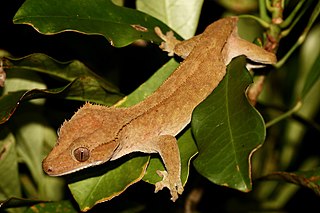
The crested gecko or eyelash gecko is a species of gecko native to southern New Caledonia (France). In 1866, the crested gecko was described by French zoologist Alphonse Guichenot. This species was thought to be extinct until it was rediscovered in 1994 during an expedition led by Robert Seipp. Along with several other New Caledonian gecko species, it is being considered for protected status by the Convention on the International Trade in Endangered Species of Wild Flora and Fauna.

The marsh owl is a medium to large species of owl in the family Strigidae.

Christinus marmoratus, also known as marbled gecko or southern marbled gecko, is a species of Gekkonidae (gecko) native to southern mainland of Australia, from Victoria to Western Australia. The species is well adapted to a variety of habitats, including city dwellings..

Nature's Valley is a holiday resort and small village on the Garden Route along the southern Cape coast of South Africa. Nature's Valley lies between the Salt River, the foothills of the Tsitsikamma Mountains, the Indian Ocean and the Groot River lagoon. Nature's Valley has a balmy climate and is surrounded by the de Vasselot Nature Reserve which is part of the Tsitsikamma Park, and in turn part of the Garden Route National Park.
Peringuey's leaf-toed gecko, also known commonly as the salt marsh gecko, is a species of lizard in the family Gekkonidae. The species is endemic to South Africa.
Pachydactylus austeni, also known commonly as Austen's thick-toed gecko or Austen's gecko, is a species of small thick-toed gecko, a lizard in the family Gekkonidae. The species is indigenous to the western coast of South Africa.

Pachydactylus geitje, also known commonly as the ocellated gecko, the ocellated thick-toed gecko and the Cradock thick-toed gecko, is a tiny species of thick-toed gecko, a lizard in the family Gekkonidae. The species is indigenous to the Western Cape of South Africa.
Goggia lineata, also known as the striped dwarf leaf-toed gecko or striped pygmy gecko, is a minute and delicate species of dwarf leaf-toed gecko that is indigenous to the western part of the Cape of South Africa. With a length of about 4 cm (1.6 in), this tiny nocturnal gecko is, along with Cryptactites peringueyi, the smallest lizard in southern Africa.
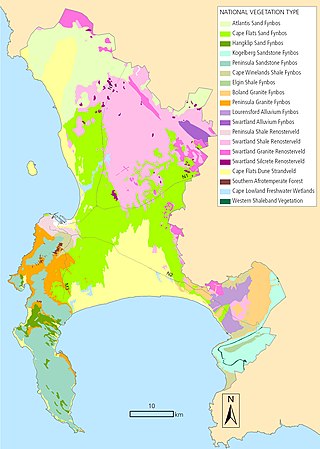
The Biodiversity of Cape Town is the variety and variability of life within the geographical extent of the City of Cape Town metropolitan municipality, excluding the Prince Edward Islands. The terrestrial vegetation is particularly diverse and much of it is endemic to the city and its vicinity. Terrestrial and freshwater animal life is heavily impacted by urban development and habitat degradation. Marine life of the waters immediately adjacent to the city along the Cape Peninsula and in False Bay is also diverse, and while also impacted by human activity, the habitats are relatively intact.
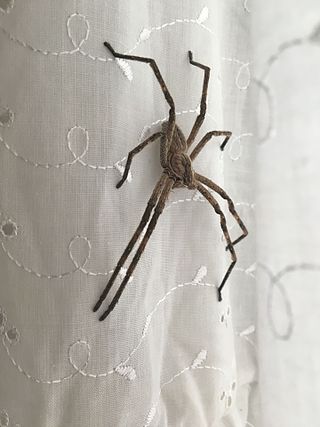
Palystes castaneus is a species of huntsman spider found in parts of South Africa. It is common from Cape Town to Heidelberg, Western Cape, especially in forested areas. In scrub outside forested areas, it is replaced by Palystes superciliosus. It occurs mainly on plants, where it hunts insects. It has a body length of 17–22 mm. P. castaneus is the type species for the genus Palystes, and was first described by Pierre André Latreille in 1819.
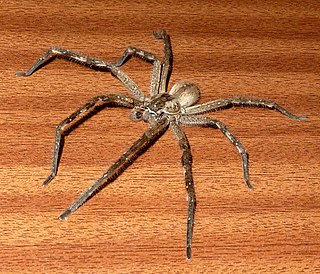
The common rain spider, formerly P. natalius, is a species of huntsman spider native to Southern Africa. It is the most common and widespread species in the genus Palystes. In South Africa its distribution ranges from KwaZulu-Natal province in the east, then westwards to the provinces of Mpumalanga, Limpopo, Gauteng and North West in the north, and Eastern Cape and Western Cape in the south. It has a body length of 15–36 mm and a leg span of up to 110mm. The species was first described by Ludwig Carl Christian Koch in 1875.
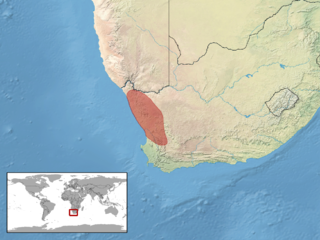
Pachydactylus labialis, commonly known as the Calvinia thick-toed gecko, Western Cape gecko, or Western Cape thick-toed gecko, is a gecko species endemic to the Western and Northern Cape in South Africa, often found taking shelter under stones.
Ichnotropis grandiceps is a species of African lizards in the family Lacertidae. They are commonly called Caprivi rough-scaled lizards as they are largely found in southwestern Africa on the border of the Caprivi Strip. The cape rough-scaled lizards are terrestrial and found in the range of open woodland and mesic savanna. The caprivi rough-scaled lizards are medium in size and distributed in parts of Namibia and Botswana. This species is on the International Union for Conservation of Nature's Red List for endangered species as they are rare and has not been seen or collected since 1998. Data about the population or specimens collected are needed for the IUCN to obtain more information about the unknown threats that may be impacting them.
Bauerius ansorgii is a species of gecko, a lizard in the family Gekkonidae. The species is indigenous to the west coast of Southern Africa.
Ramigekko swartbergensis, sometimes called the Swartberg (African) leaf-toed gecko, is a species of African gecko which is a localized endemic of the Cape Fold Belt in South Africa. It is monotypic in the genus Ramigekko.

Goggia essexi, also known commonly as Essex's dwarf leaf-toed gecko, Essex's leaf-toed gecko, and Essex's pygmy gecko, is a species of gecko, a lizard in the family Gekkonidae. The species is endemic to South Africa.
Goggia hewitti, known commonly as Hewitt's dwarf leaf-toed gecko, Hewitt's leaf-toed gecko, or Hewitt's pygmy gecko, is a species of gecko, a lizard in the family Gekkonidae. The species is endemic to South Africa.

Paroedura maingoka, the scorpion leaf-toed gecko, is a species of lizard in the family Gekkonidae. It is endemic to southwest Madagascar, where it occurs on rock outcrops in dry forests and scrubland. It is a nocturnal species, emerging to feed at night.















